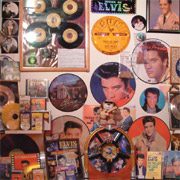Wellington to New Plymouth - Day Three
Hawera to New Plymouth

In the morning Mt Taranaki is parading his magnificent Fuji-like torso in the sun as we begin our day at Kevin Wasley’s Elvis Presley Museum. Kevin or ‘KD’ as he’s known in these parts, greets us at the curb and vigorously shakes Bob’s hand when he discovers that he’s a fellow enthusiast.
But perhaps not as passionate – when we step inside his garage it’s like a shrine, with the floors, ceiling and walls plastered in Elvis pictures, posters and newspaper cuttings. KD began his collection in 1959 when he was 14 years old and amongst the numerous exhibits are old LP covers, signed records and albums from around the world, photos, posters, number plates, cuff links, a jumble of replica clothes and endless other memorabilia. “It’s my tribute to the man,” he tells us before we depart to climb up the Hawera Water Tower. From the top we have excellent views of the vibrant, green Taranaki countryside, before we drive to Tawhiti Museum, hailed as one of the best private museums in NZ.
The brainchild of ex-art teacher, Nigel Ogle, its galleries recreate many aspects of early life in South Taranaki, from the Maori-European land wars to the struggles of the dairy industry.
“It’s so lifelike,” says Bob as we admire Nigel’s painstakingly crafted models in realistic historical settings.
We leave town on SH45, the legendary Surf Highway, which horseshoes around the coastline beneath Mt Taranaki, past several popular surfing haunts en route to New Plymouth.
In Manaia, a town centred upon an octagon-shaped roundabout and dubbed the ‘bread capital’ of NZ, we stop at Yarrows, a family owned bakery which has been in operation since 1923. Their buttery hand-rolled croissants and Danish pastries are renowned and after a Danish each, we continue onto Opunake, where we meet Dave, the town’s barber, after Bob (spotting the stripy barber’s pole) peers through the window and announces that he’s due for a cut.
While Bob attends to his grooming, I visit the eye-catching Everybody’s Theatre next door where Marilyn Monroe and Charlie Chaplin grace its billboards. Movies play every Friday and Sunday night and its interior is charming, with old-style movie chairs and posters.
When I return Bob’s hair is under control and he’s chatting to Dave about a message he discovered in a bottle. “I found it up the road,” Dave tells us, “it was sent by a guy in the South African Navy.” Quite a talking piece, the bottle is on display in his shop. “Lots of people come to see it,” he says.
For lunch we have delicious chicken cranberry pizzas followed by huge slabs of homemade chocolate cake at the Sugar Juice Café, then admire the town’s many murals, and hunt for treasures at the Old Curiosity Shop before we leave.
In Oaonui we catch a glimmer of Taranaki’s $2 billion energy industry at the Maui Production Station visitor centre before we arrive in Pungarehu. We drive through an unusual landscape of bobbly hills and cabbage trees to the Cape Egmont lighthouse where Bob takes a stunning photo of the tall beacon with Mt Taranaki in the background. In Oakura, a famous surf beach just south of New Plymouth, Bob hires a surfboard and gear from Vertigo Surf, while I don a wetsuit and go for a tandem surf ride with Greg Page on a custom-made four metre surfboard. It’s totally exhilarating and later as we stand on the beach drinking mugs of hot tea Greg tells us that he first learnt to surf with his father, balancing on the front of his board.
It turns out that Greg’s no stranger to carrying extra bodies on his board – he’s even surfed on a 28-foot board with 13 others for the Guinness Book of Records. We check out the photographs and newspaper clippings at Vertigo before we depart for Puke Ariki in New Plymouth, a unique combination of library, museum and information centre located behind the waving Len Lye wind-wand sculpture on the waterfront.
Here we learn the stories of the region, including a rendition of Mt Taranaki’s sad tale, before taking a pre-dinner stroll along the waterfront.
All of a sudden Bob stops and stares profoundly at the pounding sea. “They say Mt Taranaki’s lonesome here all by himself but you know what, I think he’s loving every minute of it - look at him now,” he drawls.
I turn to look at Mt Taranaki’s icy crown which basks in the last rays of the setting sun. He has a rosy glow and actually looks extremely content – if you believe that a mountain can find happiness. “You know Bob,” I say eventually, “I’d really have to agree.”